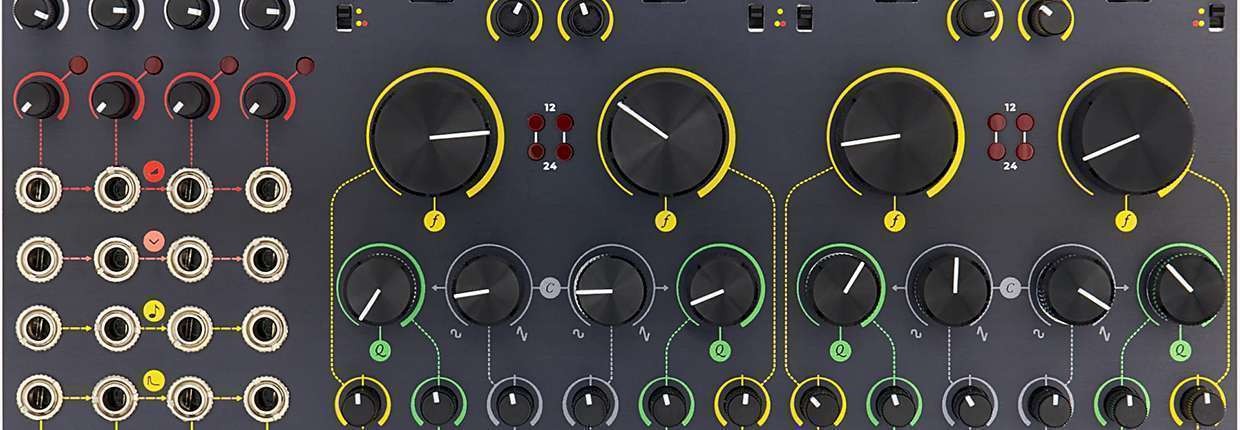Events and News
Published on 12/05/2023

CUNSA is a word from the Modena’s dialect. It means curing, seasoning (of foods) or tanning (of leathers).
Seasoning is crucial for cooking. It is a process that enhances the flavors, glues the ingredients together, and even adds some unexpected kick.
From a gentle refining touch to a shovelful of spice, CUNSA is the perfect seasoning tool for your patches. It can sweeten a sour lead or beef up an insipid bass line, and anything in between. And, just like a good oil, you can even taste it by itself!
Well, in fact CUNSA is a quadruple analog pingable multimode resonant filter, saturator, mixer, and oscillator.
It is our sound seasoning tool: it can gently even a patch, applying a final touch, or it can set it on fire with a ridiculous amount of spice. It’s up to you and your cooking style!
It consists of four multimode resonant filters with a custom saturation and feedback control that you can use independently or in various combinations and roles thanks to a series of seminormalizations. Let’s go a little deeper.
CUNSA features four filters that can be used independently or linked and mixed. Each filter provides three behaviors simultaneously: lowpass, bandpass, and highpass. Each behavior has a 12 dB/oct slope, except for the lowpass, which can be either 12 or 24 dB/oct.
CUNSA handles feedback and gain staging with extreme control and versatility. Besides the usual Q control that emphasizes the cutoff frequency, the Character circuit defines the amount of soft clipping when the filter overloads. High clipping guarantees a controlled behavior with fat tone and pure resonance, while low or no clipping lets the signal saturate the filter stages and make it scream.
Each filter responds to the V/oct signal with excellent tracking. It is thus possible to move the cutoff frequency along with the main melody or make CUNSA resonate with no input and transform it into a multiple oscillator. The V/oct inputs are seminormalled so you can control more filters with the same CV. Easy chords stabs!
CUNSA is ideal for percussive and organic tones. The Ping circuit offers a behavior similar to the BRENSO but AC-coupled. Instead of shooting the frequency to the moon with any trig, CUNSA gently responds to different incoming gates with a selectable decay curve.
The Ping circuit can thus create natural decay sounds when fed with trigs or smoother envelopes with any other voltage, like a linear integrator with a custom decay.
Besides this, you can also feed the filter’s audio input with trigs and make it ring at high Q settings.
The four filters can work independently or arranged in groups through seminormalled inputs and sum outputs.
CUNSA can thus be a 4x1, 2x2, or a massive 1x4 filter. Even odd configurations are possible, like 1+2+1 or 3+1.
Mono, stereo, or quadraphonic audio is at your fingertips.
When the filter behavior is set to COMBINED, every control of the cutoff frequency also affects the input VCA, reducing the signal amplitude and saturation as it approaches the lowest range.
It can make organic decays with the ping circuit or tame the low range at high Q and Character settings.
Four inputs have a cascaded semi normalization: audio inputs, VCA CV, V/oct, and Ping.
Every signal patched to a filter will thus feed also those at its right, making simultaneous use even simpler.
To remove a semi normalization, simply patch a dummy cable to the corresponding input.
Every filter output can be routed to an analog mix bus that sums the four filters and outputs them in three combinations: all, 1+2, and 3+4.
These outputs allow for versatile audio processing. Just like we did with FUMANA, we added a gentle shelving EQ for the higher frequencies of the All output to provide additional timbral variety.
Beside the seminormalled inputs, every filter features additional CV inputs for cutoff frequency, Q, and Character, each with a dedicated attenuverter.
Listen here to start!
Join us today and get 5% off your next order!

Empty cart